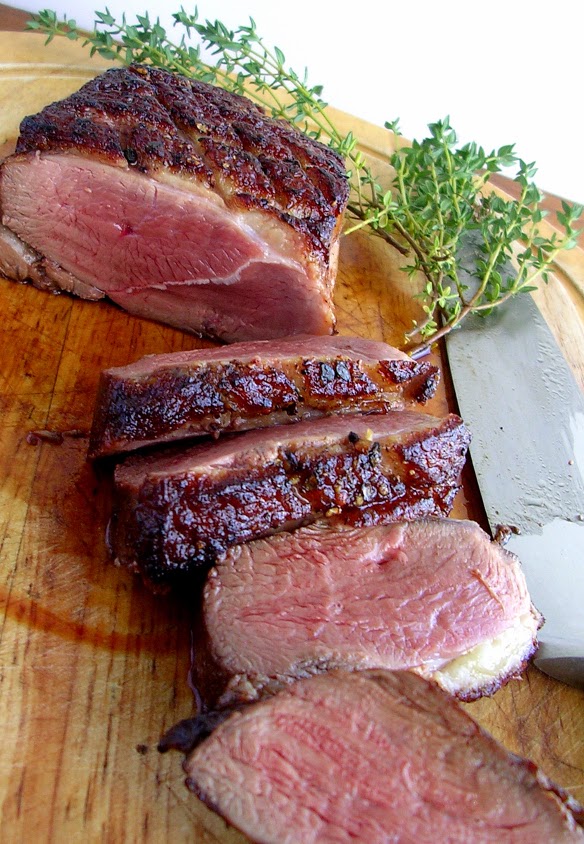The brightest spot on a winter’s day is the sunny glow of clementines dangling from the tree in my garden. I’ve picked off all the low-hanging fruit, a few every day, to eat out of hand. Now I need to get my tall son to pick what remains from the higher branches.
Clementines are a cultivar of the citrus fruit, mandarin. They are easy-to-peel, fairly free of seeds and have a perfect balance of sweet and tangy juice.
Looking for an elegant dish for a dinner party, I latched on to my clementines as a stand-in for oranges in duck a l’orange. Instead of the old-fashioned gloppy sauce, I made a bright, sweet-sour sauce with clementine juice and PX wine.
PX is a gorgeous dessert wine produced from grapes of the Pedro Ximenez (PX) variety that are sun-dried before pressing, which concentrates the fruit and sugars. The wine tastes like liquid raisins with a subtle bitter-coffee aftertaste. It is produced in Jerez/Sherry, Málaga and in the region of Montilla-Moriles (Córdoba), where the PX variety is the principal grape (also used for dry, fino type wine). Serve PX wine with fruit and pastries for dessert, with cheese, spooned over ice cream or sponge cake. Reduce it to a syrup to glaze duck or pork tenderloin.
 |
| Remove peel and pith. |
You’ll need 6 to 8 ounces boneless duck breast per serving.The half-breasts that I bought weighed about 12 ounces each, but you may find them considerably larger.
Scoring the layer of skin and fat helps to render out the fat while cooking, producing a nice crisp skin. Duck breast (also called magret) is usually served rare or medium rare, so it takes very little time to cook. It needs to rest 10 minutes before slicing. I served it with rice and sauteed pumpkin, a vegetable which goes very nicely with citrus. (Keep the reserved duck fat, refrigerated, to fry potatoes in on another day.)
 |
| Duck breast with clementine sauce--an elegant dinner. |
Magret de Pato con Salsa de Clementinas
Duck Breast with Clementine Sauce
Serves 6
3 pounds boneless duck breast halves (3-4)
Salt and freshly ground black pepper
Sprigs of fresh thyme
1 tablespoon olive oil
3 shallots, finely chopped
½ cup PX wine
1 cup chicken stock
1 tablespoon Sherry vinegar
1 teaspoon anisette liqueur (optional)
5 clementines
Duck Breast with Clementine Sauce
Serves 6
3 pounds boneless duck breast halves (3-4)
Salt and freshly ground black pepper
Sprigs of fresh thyme
1 tablespoon olive oil
3 shallots, finely chopped
½ cup PX wine
1 cup chicken stock
1 tablespoon Sherry vinegar
1 teaspoon anisette liqueur (optional)
5 clementines
With a sharp knife, score the skin and fat on the duck in a crosshatch, without cutting into the flesh. Sprinkle the duck breasts with salt, pepper and chopped thyme. Allow to come to room temperature.
Heat the oil in a saucepan and sauté the shallots until they are browned. Add the PX wine, stock, vinegar and anisette, if using. Season with ½ teaspoon salt, pepper and a sprig of thyme.
Remove the zest (peel without any white pith) from one of the clementines and add the zest to the saucepan with the juice of one clementine. Bring the sauce to a boil, then simmer until reduced by half, about 15 minutes. Taste for salt and add more, if needed. Discard the zest and sprig of thyme and set the sauce aside.
Peel the remaining clementines and divide into segments, removing as much of the membrane as possible.
Heat a heavy skillet and place the duck breasts, fat side down, in it. Cook them until fat is browned and crisped, about 5 minutes. Very carefully, pour or spoon off all the fat in the pan into a heatproof bowl.
Heat the oil in a saucepan and sauté the shallots until they are browned. Add the PX wine, stock, vinegar and anisette, if using. Season with ½ teaspoon salt, pepper and a sprig of thyme.
Remove the zest (peel without any white pith) from one of the clementines and add the zest to the saucepan with the juice of one clementine. Bring the sauce to a boil, then simmer until reduced by half, about 15 minutes. Taste for salt and add more, if needed. Discard the zest and sprig of thyme and set the sauce aside.
Peel the remaining clementines and divide into segments, removing as much of the membrane as possible.
Heat a heavy skillet and place the duck breasts, fat side down, in it. Cook them until fat is browned and crisped, about 5 minutes. Very carefully, pour or spoon off all the fat in the pan into a heatproof bowl.
Turn the duck breasts and cook the reverse side until browned, about 3 minutes for rare meat or longer for medium rare. Remove the breasts to a cutting board and allow to rest 10 minutes before slicing.
Reheat the sauce. Add 1 tablespoon of reserved duck fat to the sauce. Immediately before serving, add the clementines to the sauce.
Serve the sliced duck with sauce spooned over it.
Reheat the sauce. Add 1 tablespoon of reserved duck fat to the sauce. Immediately before serving, add the clementines to the sauce.
Serve the sliced duck with sauce spooned over it.
 |
| Citrus and sweet wine make a delicious sauce for duck breast. |
 |
| An elegant dish for a New Year's Eve dinner party. |
HAPPY NEW YEAR TO ALL.
























